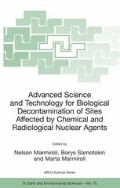Abstract
The contamination of groundwater by leakage of hydrocarbons or other pollutants from underground storage tanks, distribution systems and various industrial operations is a major environmental problem. Conventional treatment techniques suffer from serious shortcomings which limit their applicability and efficiency. These include high cost and maintenance requirements, the need to transfer the contamination from one medium to another, and the extended duration of the operation. An alternative to these treatments lies in in situ remediation. Biochemical reactions play an important role in many of these in situ remediation technologies. Commonly, micro-organisms degrade organic compounds to recover the chemical energy conserved in the C-C bonds. Complex organic molecules are thereby converted to simpler compounds and, ultimately, to carbon dioxide or methane and water. Parts of some compounds are scavenged to provide the building blocks for new bacterial cells. in situ bioremediation relies on the ability of micro-organisms (bacteria, fungi, algae, protozoa and metazoa), either attached to soil particles or suspended in the pore water, to either convert contaminants into harmless molecules such as carbon dioxide and water, or to immobilize them into non-soluble and stable forms. In natural attenuation micro-organisms just present in the contaminated aquifer degrade o precipitate the present contaminants by consuming naturally present electron donors or acceptors.
Access this chapter
Tax calculation will be finalised at checkout
Purchases are for personal use only
Preview
Unable to display preview. Download preview PDF.
References
Azadpour-Keeley, A., Russell, H. H., and Sewell, G. W., 1999, Microbial processes affecting monitored natural attenuation of contaminants in the subsurface, EPA/540/S-99/001.
Diels, L., Geets, J., Dejonghe, W., Van Roy, S., and Vanbroekhoven, K., 2005b, Heavy metal immobilization in groundwater by in situ bioprecipitation: comments and questions about carbon source use, efficiency and sustainability of the process. Consoil 2005, Proceedings of the 9th International FZK/TNO conference on Soil-Water systems, O. Uhlmann, G. J. Annokkée, F. Arendt (eds), 1622–1628.
Diels, L., Geets, J., Dejonghe, W., Van Roy, S., Vanbroekhoven, K., Szewczyk, A., and Malina, G., 2005c, Heavy metal immobilization in groundwater by in situ bioprecipitation: comments and questions about carbon source use, efficiency and sustainability of the process. Proceedings IMWA 2005 Mine closure, Departemento de Explotacion y Prospeccion de Minas (University of Oveido), Oveido (Spain). 5–7/09/2005, J. Loredo, F. Pendas (eds), ISBN 84-689-3415-1, p 355-360
Diels, L., Geets, J., Van Roy, S., Dejonghe, W., Gemoets, J., and Vanbroekhoven, K., 2005a, Bioremediation of heavy metal contaminated sites. In Soil Remediation series 6 (Proceedings of the European Summer School on Innovative Approaches to the Bioremediation of Contaminated Sites Soil Remediation series No6, ed. Faba F., Canepa P., ISBN: 88–88214–33-X, 323–338.
Fiorenza, S., and Rifai, H. S., 2003, Review of MTBE biodegradation and bioremediation, Biorem. J. 7:1-35
Grindstaff, M., 1998, Bioremediation of chlorinated solvent contaminated groundwater, Prepared for US EPA Technology Innovation Office.
Hendrickx, B., Dejonghe, W., Brennerova, M., Cernik, M., Ledere, T., Buchelli, M., Bastiaens, L., Verstraete, W., Top, E., Diels, L., and Springael, D., 2005, Dynamics of an Oligotrophic bacterial aquifer community during contact with a groundwater plume contaminated with Benzene, Toluene, Ethylbebenzene and Xylenes: an in situ Mesocosm study, Appl. Environ. Microbiol. 71:3815–3825.
Janssen, G. M. C. M., and Temminghoff, E. J. M., 2004, In situ metal precipitation in a zinccontaminated, aerobic sandy aquifer by means of biological sulfate reduction, Environ. Sci. Technol. 38:4002–4011.
Koenigsberg SS, Sandefur CA, Lapus KA, Pasrich GP (2002). Facilitated desorption and incomplete dechlorination observations from 350 applications of HRC. www.regenesis.com.
Krajmalnik-Brown, R., Hölscher, T., Thomson, I. N., Saunders, F. M., Ritalahti, K. M., and Löffler, F. E., 2004, Genetic identification of a putative vinyl chloride reductase in Dehalococcoides sp strain BAV1, Appl. Environ. Microbiol. 70:6347–6351.
Lookman, R., Borremans, B., Gemoets, J., De Ceuster, T., Hamonts, K., Dejonghe, W., Bastiaens, L., Vanbroekhoven, K., and Diels, L., 2005, Chlorinated aliphatic hydrocarbons in aquifers: assessment of anaerobic degradation potential using microcosms and molecular biological techniques, In Consoil 2005, Proceedings of the 9th International FZK/TNO conference on Soil-Water systems, O. Uhlmann, G. J. Annokkée, F. Arendt (eds), 2139–2140.
Maymo-Gatell, X., Tandoi, V., Gossette, J., and Zinder, S. H., 1997, Characterization of an H2-utilizing enrichment culture that reductively dechlorinates tetrachloroethene to vinyl chloride and ethane in the absence of methanogenesis and acetogenesis, Appl. Environ. Microbiol 61:3928–3933.
Moreels, D., Bastiaens, L., Ollevier, F., Merckx, R., Diels, L., and Springael, D., 2004, Evaluation of the intrinsic MTBE biodegradation potential of European contaminated subsurface soils in microcosms simulating in situ bioremediation conditions, FEMS Microbiol. Ecol. 49:121–128.
Salanitro, J. P., Johnson, P. C., Spinnler, G. E., Maner, P. M., Wisnieuwski, H. L., and Bruce, C., 2000, Field scale demonstration of enhanced MTBE bioremediation through aquifer bioaugmentation and oxygenation, Environ. Sci. Technol. 34:4152–4162.
Yang, Y., Pesaro, M., Sigler, W., and Zeyer, J., 2005, Identification of microorganisms involved in reductive dehalogenation of chlorinated ethenes in an anaerobic microbial community, Water Res. 39:3954–3966.
Yerushalmi, L., Manuel, M. F., and Guiot, S. R., 1999, Biodegradation of gasoline and BTEX in a microaerophilic biobarrier, Biodegradation 10:341–352.
Author information
Authors and Affiliations
Editor information
Editors and Affiliations
Rights and permissions
Copyright information
© 2007 Springer
About this paper
Cite this paper
DIELS, L., LOOKMAN, R. (2007). MICROBIAL SYSTEMS FOR IN-SITU SOIL AND GROUNDWATER REMEDIATION. In: Marmiroli, N., Samotokin, B., Marmiroli, M. (eds) Advanced Science and Technology for Biological Decontamination of Sites Affected by Chemical and Radiological Nuclear Agents. NATO Science Series: IV: Earth and Environmental Sciences, vol 75. Springer, Dordrecht. https://doi.org/10.1007/978-1-4020-5520-1_4
Download citation
DOI: https://doi.org/10.1007/978-1-4020-5520-1_4
Publisher Name: Springer, Dordrecht
Print ISBN: 978-1-4020-5518-8
Online ISBN: 978-1-4020-5520-1
eBook Packages: Earth and Environmental ScienceEarth and Environmental Science (R0)

